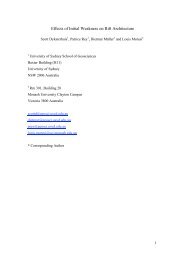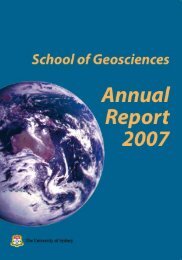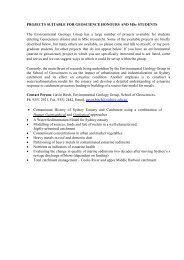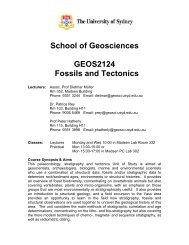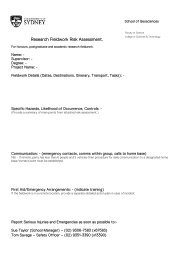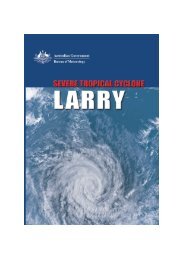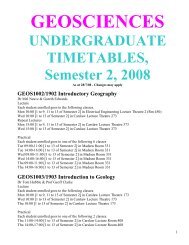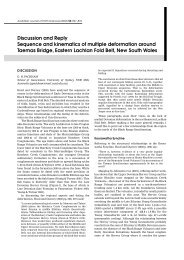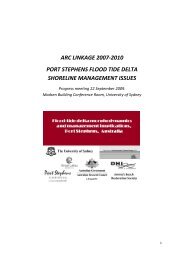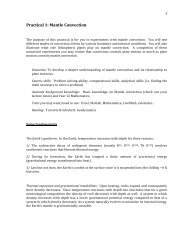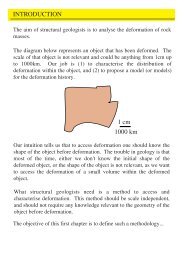van den Berg et al., 2005, Earth Planetary Science Letters.
van den Berg et al., 2005, Earth Planetary Science Letters.
van den Berg et al., 2005, Earth Planetary Science Letters.
You also want an ePaper? Increase the reach of your titles
YUMPU automatically turns print PDFs into web optimized ePapers that Google loves.
A.P. <strong>van</strong> <strong>den</strong> <strong>Berg</strong> <strong>et</strong> <strong>al</strong>. / Physics of the <strong>Earth</strong> and Plan<strong>et</strong>ary Interiors 149 (<strong>2005</strong>) 259–278 263<br />
3273, 3773 and 4273 K. The initi<strong>al</strong> temperature field<br />
of the mantle in the cases with different T CMB (0) were<br />
computed by applying an appropriate uniform sc<strong>al</strong>ing<br />
factor to the initi<strong>al</strong> mantle temperature of the intermediate<br />
case (T CMB (0) = 3773 K). The latter is obtained<br />
from a statistic<strong>al</strong>ly steady-state equilibrium model run<br />
with enhanced (R = 40) and constant intern<strong>al</strong> heating<br />
with a zero heat flux bottom boundary.<br />
For the therm<strong>al</strong> diffusivity κ = k(T, P)/ρc p we use<br />
the temperature- and pressure-depen<strong>den</strong>t conductivity<br />
Hofmeister model (Hofmeister, 1999)<br />
( ) 298 a<br />
k(T, P) = k 0<br />
T<br />
× exp<br />
×<br />
[ (<br />
− 4γ + 1 )<br />
]<br />
α(P)(T − 298)<br />
3<br />
(<br />
1 + K′ 0 P )<br />
+<br />
K 0<br />
3∑<br />
fb i T i (5)<br />
i=0<br />
In (5) the first term gives the phonon contribution to the<br />
effective conductivity and the second term is the contribution<br />
from photon transport. The amplification factor<br />
f (e.g. <strong>van</strong> <strong>den</strong> <strong>Berg</strong> <strong>et</strong> <strong>al</strong>., 2002) of the photon term,<br />
v<strong>al</strong>ued f = 1 in the Hofmeister model (Hofmeister,<br />
1999), is used here as a control param<strong>et</strong>er to vary the<br />
relative contribution of both mechanisms in the effective<br />
therm<strong>al</strong> conductivity. We consider in particular<br />
models with f v<strong>al</strong>ues of 0, 1, 2 and 5 to investigate<br />
the impact of the radiative therm<strong>al</strong> conductivity on the<br />
model behavior. We have not considered the grain-size<br />
depen<strong>den</strong>ce of therm<strong>al</strong> conductivity, which can vary<br />
non-monotonic<strong>al</strong>ly with depth (Hofmeister, 2004).<br />
The phonon term decreases with increasing temperature,<br />
∂k lat /∂T < 0 and increases with increasing pressure,<br />
∂k lat /∂P > 0. The photon term on the other hand<br />
increases with temperature ∂k rad /∂T > 0 and is insensitive<br />
to pressure ∂k rad /∂P = 0.<br />
To interpr<strong>et</strong> the numeric<strong>al</strong> modelling results we will<br />
<strong>al</strong>so use the therm<strong>al</strong> resistivity, defined as the inverse of<br />
the therm<strong>al</strong> conductivity r = 1/k, in an<strong>al</strong>ogy with the<br />
theory of electricity. One-dimension<strong>al</strong> depth profiles of<br />
horizont<strong>al</strong>ly averaged resistivity can then be integrated<br />
from a boundary point z b to obtain a resistance profile<br />
R(z) through therm<strong>al</strong> boundary layers of the mantle,<br />
the lithosphere and the CMB region<br />
R(z) =<br />
∫ z<br />
z b<br />
〈 1<br />
k(z ′ )<br />
〉<br />
dz ′ (6)<br />
This therm<strong>al</strong> resistance has been in use in geothermics<br />
as a means of obtaining reliable heatflow estimates<br />
from bore holes with strongly fluctuating conductivity<br />
profiles (Beardsmore and Cull, 2001; Bullard,<br />
1939).<br />
For the rheologic<strong>al</strong> model we have chosen an exponenti<strong>al</strong><br />
temperature and depth (pressure) depen<strong>den</strong>t<br />
viscosity for Newtonian rheology<br />
η(T, z) = η 0 exp(cz − bT ) (7)<br />
where c, b are defined in Table 1 in terms of the viscosity<br />
contrasts across the convecting layer due to depth<br />
(pressure) (η P ) and temperature (η T ), respectively.<br />
The v<strong>al</strong>ue of η P is fixed at 100. For most cases, the<br />
v<strong>al</strong>ue of η T is 3000, but for comparison we <strong>al</strong>so show<br />
some contrasting cases.<br />
Eqs. (1), (2) and (4) are solved by using finite element<br />
m<strong>et</strong>hods for the spati<strong>al</strong> discr<strong>et</strong>ization, and applying<br />
a pen<strong>al</strong>ty function m<strong>et</strong>hod for the continuity equation<br />
and Stokes momentum equations (1) and (2). The<br />
energy equation (4) which drives the time depen<strong>den</strong>t<br />
system is integrated in time using a predictor corrector<br />
m<strong>et</strong>hod (<strong>van</strong> <strong>den</strong> <strong>Berg</strong> <strong>et</strong> <strong>al</strong>., 1993). The finite element<br />
mesh consists of 150 × 140 nod<strong>al</strong> points in the<br />
horizont<strong>al</strong> and vertic<strong>al</strong> direction, respectively. Mesh refinement<br />
was applied near the horizont<strong>al</strong> boundaries,<br />
where the vertic<strong>al</strong> nod<strong>al</strong> point spacing was reduced to<br />
6 km from a v<strong>al</strong>ue of 30 km in the interior domain.<br />
Mesh refinements near the therm<strong>al</strong> boundary layers<br />
is essenti<strong>al</strong> in c<strong>al</strong>culations using variable conductivity<br />
due to the occurrence of strong temperature gradients<br />
and similar sharp variations in the effective therm<strong>al</strong><br />
conductivity in the boundary layer (see Yuen <strong>et</strong><br />
<strong>al</strong>., 2000), which need to be resolved numeric<strong>al</strong>ly. Especi<strong>al</strong>ly<br />
the computation of the surface heat-flux requires<br />
a very high resolution of the finite element mesh<br />
(<strong>van</strong> <strong>den</strong> <strong>Berg</strong> <strong>et</strong> <strong>al</strong>., 2001).<br />
We use free-slip impermeable boundaries and a<br />
fixed top surface temperature of 273 K. On the vertic<strong>al</strong><br />
boundaries a zero heat flux symm<strong>et</strong>ry condition<br />
was applied. The model runs were started<br />
from a statistic<strong>al</strong>ly steady state obtained for a zero<br />
heat flux bottom boundary and constant intern<strong>al</strong><br />
heating.<br />
Therm<strong>al</strong> coupling b<strong>et</strong>ween mantle and core is represented<br />
by an isotherm<strong>al</strong> heat reservoir of the core,<br />
shown in Fig. 1, where the temperature T C is controlled<br />
by the average heat-flow from the core–mantle bound-



